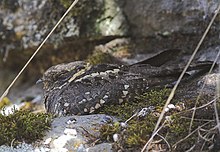Montane nightjar
| Montane nightjar | |
|---|---|

| |
| Scientific classification | |
| Kingdom: | |
| Phylum: | |
| Class: | |
| Order: | |
| Family: | |
| Genus: | |
| Species: | C. poliocephalus
|
| Binomial name | |
| Caprimulgus poliocephalus Rüppell, 1840
| |
The montane nightjar, mountain nightjar or Abyssinian nightjar (Caprimulgus poliocephalus) is a species of nightjar in the Caprimulgidae family. It is native to upland regions of Central and Eastern Africa where it is a locally common species.
Description
The montane nightjar is a rather dark nightjar growing to a length of about 23 cm (9.1 in). It has somewhat tawny, blackish or chocolate brown dappled plumage. The male has white spots on its four main primaries and the outer edge of the tail is white. The female has buff-coloured spots on its primaries and less white on the tail. The call is a nasal ank-ank-ank, often followed by a high-pitched whistle piiiyu-pirrr, the first syllable descending and then rising, and the second syllable tremulous and descending.[2]
Distribution and habitat
The montane nightjar is native to Central and Eastern Africa. Its range includes Angola, Democratic Republic of the Congo, Eritrea, Ethiopia, Kenya, Malawi, Saudi Arabia, Sudan, Tanzania, Uganda and Zambia. It occurs at altitudes between about 1,000 and 3,350 m (3,300 and 11,000 ft).[1] Like other nightjars, it is nocturnal, feeding on moths and other large insects. It is mostly a forest bird, but is also found in plantations, cultivated areas near forests, and in well-wooded urban areas.[2]
Status
The montane nightjar is a common species with a very wide range. No special threats have been identified and the population trend is thought to be stable. For these reasons, the International Union for Conservation of Nature has rated its conservation status as being of "least concern".[1]
References
- ^ a b c Template:IUCN
- ^ a b Nigel Redman; Terry Stevenson; John Fanshawe (2016). Birds of the Horn of Africa: Ethiopia, Eritrea, Djibouti, Somalia and Socotra. Bloomsbury Publishing. p. 224. ISBN 978-1-4081-2580-9.

